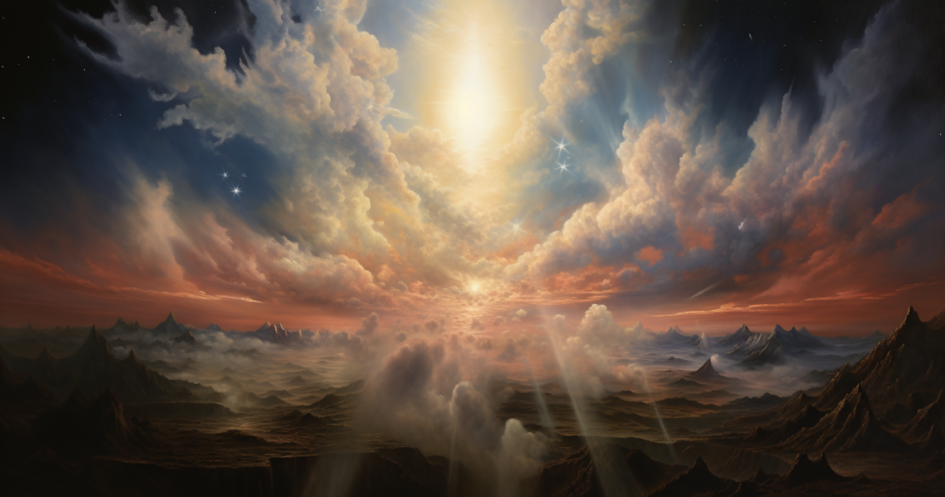Is there continuity or conflict?
Genesis 1:1-2 – “In the beginning God created heaven, and earth. And the earth was void and empty, and darkness was upon the face of the deep; and the spirit of God moved over the waters.”
Astrophysics Finding: The universe began with the Big Bang, a singularity that initiated the expansion of space and time.
Genesis 1:3 – “And God said: Be light made. And light was made.”
Astrophysics Finding: The early universe was filled with a glowing, dense plasma. As it expanded and cooled further, photons were able to travel freely, creating the cosmic microwave background radiation, which is a remnant of the early light of the universe.
Genesis 1:4-5 – “And God saw the light that it was good; and he divided the light from the darkness. And he called the light Day, and the darkness Night; and there was evening and morning one day.”
Astrophysics Finding: After the Big Bang, the universe was initially a hot, dense state. As it expanded and cooled, matter began to clump together, eventually forming galaxies, stars, and cosmic structures.
Genesis 1:6-8 – “And God said: Let there be a firmament made amidst the waters: and let it divide the waters from the waters. And God made a firmament, and divided the waters that were under the firmament, from those that were above the firmament, and it was so. And God called the firmament, Heaven; and the evening and morning were the second day.”
Astrophysics Finding: As the universe expanded and cooled, clouds of gas and dust collapsed under gravity, giving rise to the formation of stars and galaxies. These cosmic structures are considered the “heavens” in the biblical context.
Genesis 1:9-10 – “God also said: Let the waters that are under the heaven, be gathered together into one place: and let the dry land appear. And it was so done. And God called the dry land, Earth; and the gathering together of the waters, he called Seas. And God saw that it was good.”
Astrophysics Finding: The formation of Earth involved the accumulation of matter and the differentiation of land and water. The dynamic processes of tectonic activity and the water cycle contributed to the shaping of the Earth’s surface as we know it today.
Genesis 1:11-13 – “And he said: Let the earth bring forth the green herb, and such as may seed, and the fruit tree yielding fruit after its kind, which may have seed in itself upon the earth. And it was so done. And the earth brought forth the green herb, and such as yieldeth seed according to its kind, and the tree that beareth fruit, having seed each one according to its kind. And God saw that it was good. And the evening and the morning were the third day.”
Astrophysics Finding: Following the formation of the Earth, the emergence of plant life coincided with the development of photosynthesis and the proliferation of diverse flora. These processes contributed to the richness and variety of vegetation on Earth.
Genesis 1:14 – “And God said: Let there be lights made in the firmament of heaven, to divide the day and the night, and let them be for signs, and for seasons, and for days and years.”
Scientific Description: This verse aligns with the scientific understanding of celestial bodies, including stars, planets, and moons. The lights in the firmament refer to the formation of these celestial bodies, which provide illumination and enable the measurement of time. They serve as signs, helping us navigate and determine seasons, days, and years based on their positions and movements.
Genesis 1:20 – “And God said: Let the waters bring forth the creeping creature having life, and the fowl that may fly over the earth under the firmament of heaven.”
Scientific description: This verse corresponds to the diversification of life in aquatic environments and the emergence of avian species. It reflects the scientific understanding that the waters are teeming with various forms of marine life, including fish, mammals, and invertebrates. The fowl that fly over the earth represent the evolution of birds, which have adapted to various habitats and developed the ability to fly.
Genesis 1:24 – “And God said: Let the earth bring forth the living creature in its kind, cattle and creeping things, and beasts of the earth, according to their kinds.”
Scientific description: This verse aligns with the scientific understanding of the emergence of terrestrial life forms. It encompasses the formation of diverse animal species on land, including mammals (cattle, beasts of the earth) and reptiles (creeping things). The phrase “according to their kinds” acknowledges the existence of different species, each with its own unique characteristics.
Genesis 1:26 – “And he said: Let us make man to our image and likeness: and let him have dominion over the fishes of the sea, and the fowls of the air, and the beasts, and the whole earth, and every creeping creature that moveth upon the earth.”
Scientific description: This verse reflects the creation of human beings and their unique role as stewards of the Earth. It acknowledges humanity’s dominion over the natural world, including marine life, avian species, terrestrial animals, and all creatures on land. It emphasizes the responsibility to care for and protect the Earth and its diverse ecosystems.
Genesis 1:31 – “And God saw all the things that he had made, and they were very good. And the evening and morning were the sixth day.”
Scientific description: This verse signifies the completion of the creation narrative, with God observing that everything He made was very good. It recognizes the intricate and interconnected nature of the created world, with its diverse forms of life and functioning ecosystems. The mention of the evening and morning as the sixth day implies the culmination of the creation process.
While these scientific descriptions provide insights into the natural processes involved, it is important to note that Genesis also carries theological and spiritual meanings that go beyond scientific explanations. The interpretation of these verses may vary among individuals and religious traditions.
 The Libertarian Catholic
The Libertarian Catholic
















